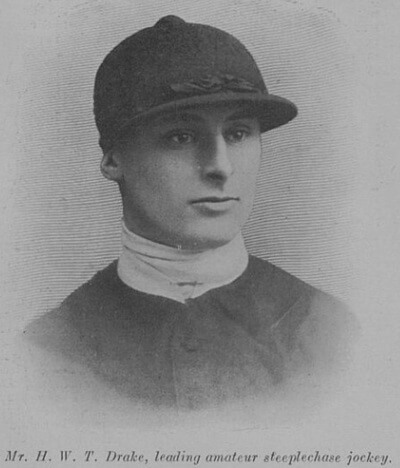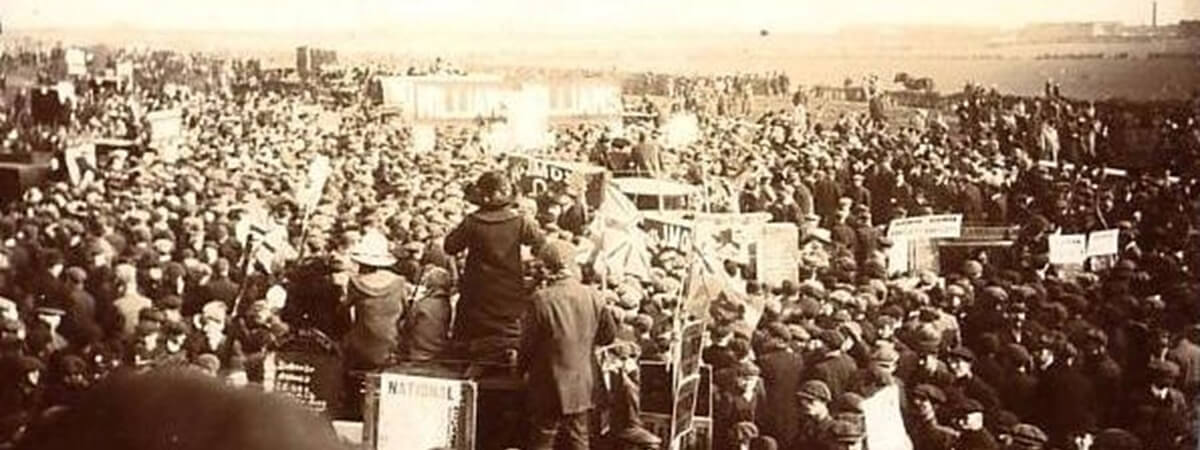By Alison Bailey

Perhaps surprisingly, Amersham has a long connection to the Grand National, the popular National Hunt steeplechase, which has been held at Aintree since 1839. In 1860, Edward Tyrwhitt-Drake of Shardeloes finished sixth on Bridegroom. His great nephew, Jack Tyrwhitt-Drake, rode in four Grand Nationals. His best place was third in 1913 behind his father’s horse, Irish Mail, who finished second. The whole town believed that if Jack Drake had been riding Irish Mail, then the most important race in the country would have been won by a horse owned and trained in Amersham!
In 1939, the eccentric and incredibly wealthy, racehorse owner, Dorothy Paget, moved to Hermit’s Wood, Chalfont St Giles. In 1934 her horse Golden Miller became the first, and only horse to win the Cheltenham Gold Cup and the Grand National in the same year but her story needs another article.
Reverand Edward Tyrwhitt-Drake

Edward Tyrwhitt-Drake (1832-1904) was born the third son of four, of Squire Thomas Tyrwhitt-Drake, Master of Fox Hounds of the Bicester Hunt, and his wife, Barbara Annesley, a keen horsewoman. Their four sons hunted three or four days each week for seven months of the year and were, according to the local press, considered some of the finest sportsmen of their generation. Edward, known as Teddy Drake, or The Bishop by his friends, played cricket at the highest level for the Gentlemen of England team and was famous on the hunting field as “the fastest man across country”.
Not surprisingly, Teddy also took up horse racing, as did his younger brother George. Teddy entered steeplechases at Oxford, where he was studying for the Church, before taking part in the 1860 Grand National, under the assumed name, Mr Ekard (Drake backwards). He is believed to be the only jockey who rode in the Grand National after having taken Holy Orders.
In 1863, after losing most of his modest allowance gambling in his youth, Teddy was delighted, and probably relieved at the age of 31, that his elder brother, now Lord of the Manor, gave him the wealthy living of St Mary’s Amersham. Teddy held this position for the next 43 years but did not give up his sport. He is believed to be the inspiration for Trollope’s Hunting Parson in his 1865 Hunting Sketches and was known to wear his riding clothes under his vestments so that he could be mounted within minutes of leaving the pulpit.
Racehorses at Shardeloes

Edward’s elder brother Thomas (known as Young Tom) inherited Shardeloes in 1852 and introduced the first racehorses to the stables there. This expensive new hobby probably helped persuade the squire to finally sell some of his land to the Metropolitan railway. Tom was considered a good judge of flat racing and was even elected to the Jockey Club despite not owning any racehorses at the time. When he started racing his own horses his jockeys wore crimson silk with a black cap, a tradition followed by his son and grandson. In recent years, William Tyrwhitt-Drake, the current Lord of the Manor of Amersham, owned horses who ran in his family’s colours.
Whilst Young Tom had some success in minor races, it was his son William and grandson Jack, who developed the racing stables in Amersham. Tom died in 1888, and the estate was inherited by his eldest son, another Thomas, also a keen huntsman and master of the OBH West. He died in 1900 without a male heir, so the estate now passed to his brother William, who followed the family hunting tradition as Master of Hounds but was equally keen on steeplechase racing, as were his two sons, Jack and Teddy. All three sometimes raced together with Tyrwhitt-Drakes finishing first and second on more than one occasion. Unlike in flat racing, under National Hunt rules it was permissible to hold both a trainer’s and a jockey’s license, which both William and Jack did.
A Gentleman Jockey
Herbert William ‘Jack’ Tyrwhitt-Drake (1885-1915) was the first of four children born to William and his wife, Augusta Peel. Educated at Eton and Uppingham he moved to Shardeloes when he was 15 after his father inherited the estate and became Lord of the Manor of Amersham.
Like all Drakes, Jack was an accomplished horseman having learnt to ride on his grandfather’s spotted pony almost before he could walk and soon joined the local hunts. By the time he was 16, Jack had won a point-to-point after having to carry eight stone of dead weight to make the 14 stone limit. However, his slight build was a distinct advantage in his chosen career of amateur jockey. Jack graduated to riding under National Hunt rules and won his first race in 1905 on Doncaster Rock, by 20 lengths.
Jack rode as an amateur steeplechase jockey but he followed the racing schedule to all the major races as persistently as any professional. He mainly, but not exclusively, rode his father’s horses and in 1911 took over their training, with the support of Frank Emmerson. That same year he rode 61 winners, winning the Amateur jockey title and was runner -up in the Jockeys’ Championship. Jack’s biggest wins came on Carsey in the 1911 Grand Sefton Chase, on Main Royal in the 1911 £850 Grand International Chase at Blackpool, and Irish Mail in the 1913 Great Lancashire Chase.
Jack rode four times in the Grand National. He fell in two, came fourth on Carsey in 1912 and was placed third on Carsey after remounting in 1913. Whilst an incredible race for Amersham with the second placed Irish Mail trained in the town, it was a disastrous race for the sport with only three horses completing the course from 22 starters.
In total Jack rode in 720 races, won 160 and was placed in 250. However, he also had a good reputation as a trainer of steeplechasers, exercising his string of horses at Shardeloes every morning, using the local hills to build strength and stamina.
Irish Mail
In 1912 William purchased a promising horse to add to the stable. Irish Mail was a five-year old brown gelding, sired by King’s Messenger out of Betsy Shannon. The horse was developed under the watchful eyes of William, Jack and Frank Emmerson who thought he had potential for the Grand National. The training ground was in Hand Meadow and a training course was made parallel to the footpath in Rough Park, leading to Mop End. A starting gate was erected at the Mop End extremity of Hand Meadow and there were models of the Aintree Grand National fences which included Beechers Brook and the Canal Turn.
Jack won several races on Irish Mail, but a prior commitment prevented him from riding the horse in the Grand National. He felt he had to honour a promise to Lady Torrington that should she ever enter a horse; he would ride it for her. When her Carsey was entered, Jack kept his word.
An old resident remembered that “There was consternation at Shardeloes for there was no alternative but to look for a professional rider. Owen Anthony was available and took the ride. He was not able to do more than try the horse out over the training course. There was no time to ride it in an actual race. Even so, he was able to ride Irish Mail into second place on the day at Aintree. Everyone, including the Squire and Frank Emmerson, knew that had Jack Drake ridden the horse, they would have had the winner. The whole town also knew that Amersham had been deprived of a Grand National winner owned and trained in the town”.
At the end of the month William sold Irish Mail to Sir Charles Assheton Smith for 2,500 guineas. Jockey Owen Anthony later had success as a trainer when he trained the 1922 Grand National winner, Music Hall, and Dorothy Paget’s horses in the 1930s.
The end

At the outbreak of war in 1914, Jack was one of the first to enlist in the 19th Hussars. His rank meant that he could have been given a commission but instead he chose to join the ‘Jockeys’ Regiment’ as Private 16178, with his closest friend and companion, fellow jockey Peter Hodgson Roberts. Percy Woodland, the jockey who beat Jack in the 1913 Grand National on Covertcoat also enlisted in the 19th Hussars. During training Jack was frequently given leave to fulfil racing commitments, winning at Sandown in October and Windsor in December. His last race was at Gatwick, 19 January 1915, where he raced against Ernest Piggott (the three times Grand National Winner and grandfather of Lester Piggott). Both were unplaced. At the end of the month Jack was mobilised and sent to France with his regiment.
Despite his fitness, Jack contracted pneumonia in the cold and wet conditions at the front. He died 11 March 1915, aged 29 at the 14th General Military Hospital, Boulogne. His mother Augusta had raced to France, after leaving his seriously ill father at home, but arrived too late to see her son alive. Jack is buried at Wimereux Communal Cemetery, France and commemorated on the Amersham War Memorial.
Jack’s heartbroken father never hunted again and sold all his breeding stock and steeplechasers at Tattersall’s auction in Knightsbridge four months after Jack’s death. William never fully recovered and died in 1919. The estate was inherited by Jack’s brother, Teddy who had returned from the war, where he had served with the 21st Lancers, physically and mentally exhausted. Teddy acted as MFH for the OBH West and continued to maintain the family’s stable of hunters and kennels at Coldmoreham Farm but the era of steeplechase racing at Shardeloes had ended.
Jack Drake’s life is commemorated in Lorraine Bateman’s book, A Son of Shardeloes.
Whilst researching his story in the Times’ archives, she found a letter from Jack, submitted to the Morning Post in 1912:
My one regret by H W Tyrwhitt-Drake, the leading amateur steeplechase jockey
“My one desire is, of course to be in the saddle, riding winners, and I expect to be able to do so again directly the year turns. My great regret, though – no small one either – doesn’t concern racing. Not very long ago, when Mr. Lloyd George was motoring, he lost his way and he put up at my stable yard at Shardeloes, Amersham (Bucks). The unfortunate part was that I wasn’t home at the time to prevent him getting out again!”
Jack’s sense of humour is evident but he obviously “was not a reformist behind the ideals of Lloyd George, but a supporter of the old order in which his family had thrived for generations”.
Sources:
A Son of Shardeloes, Lorraine Bateman
Ancestry
Jockeys -T – Jack Tyrwhitt-Drake
British Newspaper Archive
1913 Grand National Ultimate History
Hampshire-Life-14-Feb-2018-Thrings-meets-William-Tyrwhitt-Drake.pdf

